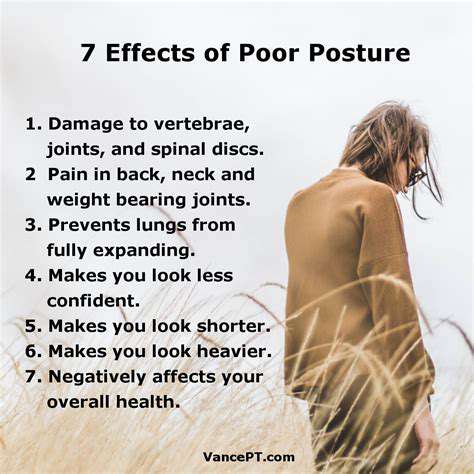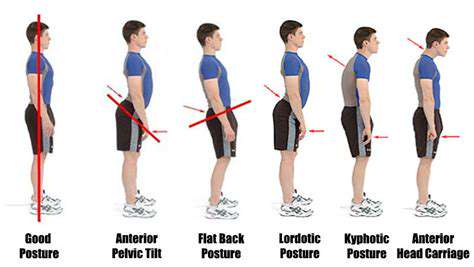The Health Risks Associated with Poor Posture

Understanding the Physical Impacts of Poor Posture
Poor posture leads to a variety of physical health issues that can significantly impact an individual's quality of life. One of the most immediate consequences is the development of musculoskeletal pain. This pain often manifests in the back, neck, and shoulders, making routine activities increasingly difficult to perform. Over time, these issues can evolve into chronic pain, requiring medical intervention.
Moreover, maintaining an improper posture can lead to complications with joint health. The way we hold our bodies influences the alignment of our joints, causing unnecessary stress and strain. For instance, slouching while seated can misalign the spine, contributing to long-term joint deterioration. As this condition worsens, individuals may find themselves facing more severe mobility issues, reducing their overall physical activity.
In addition to pain and mobility issues, poor posture can negatively influence respiratory function. When the spine is not in proper alignment, it's common for the rib cage to compress, restricting lung capacity. This limitation can lead to decreased oxygen flow to the body, affecting energy levels and overall health.
Another often-overlooked consequence of poor posture is its relationship with digestion. Poor alignment can hinder the body's ability to properly digest food, leading to discomfort and gastrointestinal issues. This can further contribute to feelings of lethargy and reduced productivity throughout the day.
Finally, the interplay of physical activities and posture cannot be ignored. Many sports and physical exercises require proper alignment to avoid injuries. Engaging in physical activities with poor posture can elevate the risk of injuries, hindering performance and discouraging regular exercise.
The Psychological Implications of Poor Posture
While the physical ramifications of poor posture are evident, the psychological effects are equally profound. Research has shown that body language and posture can significantly influence mood and self-perception. For instance, individuals who slouch may experience feelings of low self-esteem and confidence. This not only affects how they view themselves but also how they are perceived by others.
Moreover, poor posture has been linked to increased levels of stress and anxiety. When the body is in a slouched position, the brain receives signals associated with defeat or submission, potentially exacerbating feelings of anxiety. This creates a cycle where poor posture leads to stress, and increased stress may lead to further decline in posture.
Additionally, studies indicate that maintaining an upright posture can enhance cognitive function. People with better posture have been seen to experience improved concentration and mental clarity. Conversely, adopting a hunched position can lead to mental fatigue and a reduction in overall productivity. This can be particularly detrimental in environments requiring focus, such as workplaces or educational settings.
Social interactions can also be affected by posture. Individuals who exhibit poor posture might unintentionally signal disinterest or lack of engagement during conversations. Over time, this can lead to strained relationships and a decrease in social opportunities, further impacting mental health.
Finally, awareness and correction of posture can yield positive psychological benefits. Engaging in posture-improving practices, like yoga or Pilates, not only helps to realign the body but also promotes mindfulness and relaxation. This holistic approach can alleviate stress and foster a greater sense of well-being and self-awareness.
Identifying Poor Posture

Common Signs of Poor Posture
Many individuals fail to recognize the signs of poor posture until they have become chronic issues. This is why it's crucial to be aware of the symptoms that arise from sustained poor posture. Common signs include aches and pains in the neck and back, which can often be attributed to slumping or hunching over. Over time, these discomforts can lead to more serious conditions such as spinal misalignment or nerve compression, highlighting the need for early intervention.
Additionally, poor posture may manifest through physical appearance; individuals may notice themselves appearing shorter or more slouched over time. Recognizing these changes early can prevent further deterioration of posture and enhance overall health. It's essential to routinely check in with our body, especially during long hours of sitting or standing, to ensure that we maintain a healthy alignment.
Moreover, individuals might experience fatigue or decreased energy levels as a result of poor posture. This lack of vitality can significantly impact productivity and mood throughout the day. When the body is out of alignment, it works harder to maintain balance, leading to unnecessary strain and exhaustion.
Finally, it’s important to note that poor posture can also affect digestion and breathing. When the body is slouched, the organs can become compressed, leading to a host of digestive issues. By being alert to these signs, individuals can take proactive steps toward correcting their posture and improving their overall well-being.
Consequences of Neglecting Posture
The long-term consequences of neglecting posture should not be underestimated. Chronic poor posture can lead to severe musculoskeletal disorders that may require medical intervention. This includes conditions such as herniated disks and sciatica, which can significantly impact quality of life. As discomfort becomes consistent, many individuals find themselves seeking chiropractic or physical therapy, which can be both costly and time-consuming.
Besides physical effects, the psychological implications of poor posture are significant as well. Research indicates that poor posture can lead to decreased self-confidence and increased feelings of anxiety. When individuals are slouched or hunched, they may project a sense of defeat, which can impact social interactions and personal relationships.
A lack of awareness about one’s posture can also result in reduced athletic performance. Proper alignment is critical in virtually all sports and physical activities, as it maximizes strength and efficiency. Poor posture can hinder movement, making individuals more prone to injuries during exercise or athletic events.
Lastly, neglecting to address poor posture can contribute to chronic fatigue syndrome. When the body is aligned properly, energy flows more efficiently through the body, allowing for optimal performance. Over time, maintaining a poor posture can drain energy reserves, leading to lethargy and sluggishness that can affect all areas of life.
Effective Strategies to Improve Your Posture
Understanding the Importance of Good Posture
Good posture is often overlooked, yet it plays a crucial role in overall health and well-being. Proper alignment of the body not only enhances appearance but also supports optimal function of internal organs. When we maintain good posture, it contributes positively to our respiratory efficiency, allowing for better oxygen flow and lung capacity. This, in turn, can improve energy levels and overall vitality.
Additionally, our posture directly affects our mood and confidence levels. Studies have shown that individuals who practice good posture tend to experience less anxiety and greater self-esteem. When we stand tall and align our bodies correctly, it sends signals to our brain that we are strong and capable, which can have profound effects on our mindset and mental health.
In contrast, poor posture can lead to a multitude of health issues, including chronic pain, fatigue, and even digestive disturbances. When the spine is misaligned, it can put unnecessary strain on muscles and ligaments, leading to discomfort and long-term complications. Understanding the significance of good posture is the first step toward taking proactive measures to improve it.
Ultimately, improving posture is a holistic endeavor that integrates physical health with mental and emotional well-being. By committing to this practice, we not only foster a healthier body but also cultivate a more confident and resilient attitude towards life’s challenges.
Simple Exercises for Posture Improvement
Incorporating simple exercises into your daily routine can significantly bolster your posture. One highly effective exercise is the wall angel, which helps to strengthen the muscles responsible for holding the spine in alignment. To perform this exercise, stand with your back against the wall and slowly raise your arms while keeping them flat against the wall. This promotes awareness of shoulder positioning and back alignment.
Another beneficial exercise is the plank variation. Planks engage core muscles, which are vital for supporting the spine and maintaining good posture. To execute a basic plank, position yourself face down, resting on your forearms and toes, while keeping your body in a straight line from head to heels. Aim to hold this position for 30 seconds initially, gradually increasing the time as your strength improves.
Stretching is equally important for posture correction. Tight muscles can contribute to poor alignment; thus, incorporating stretches such as the chest opener can be invaluable. To perform a chest opener, clasp your hands behind your back and gently pull your shoulders down while opening your chest. This counteracts the forward hunch often seen in individuals who sit for extended periods.
Maintaining consistency with these exercises is key. Engaging in short sessions daily or integrating them into your existing workout routine can lead to significant improvements over time. By committing to regular posture-enhancing exercises, you can cultivate a more aligned body and reduce the risk of pain and injury.
Ergonomics and Daily Habits to Support Posture
Creating an ergonomic workspace is one vital strategy in enhancing posture. This involves adjusting your chair, desk, and computer setup to foster alignment. Ideally, your feet should rest flat on the ground, with your knees at a right angle to your hips. The computer screen should be at eye level, preventing the need to lean forward or look down, which can strain the neck and back.
In addition to workspace adjustments, developing mindful habits can further support posture improvement. For instance, making a habit of standing up and stretching every hour during long periods of sitting can relieve muscle tension and reset your posture. Simple reminders, such as setting a timer or using apps that promote movement, can assist in emphasizing the importance of taking breaks.
It's also beneficial to be aware of your posture during everyday activities, such as walking or carrying objects. Developing the habit of consciously uplifting your chest and relaxing your shoulders while walking can have a lasting impact. Similarly, using proper techniques for lifting—such as bending at the knees rather than the waist—can prevent back injuries and further cultivate good posture.
Lastly, cultivating relaxation techniques can prove advantageous. Stress can lead to muscle tension which, over time, may contribute to poor posture. Practices such as yoga and deep-breathing exercises can not only reduce stress but also promote awareness of body positioning. This holistic approach to posture aligns physical health with mental clarity, leading to overall well-being.